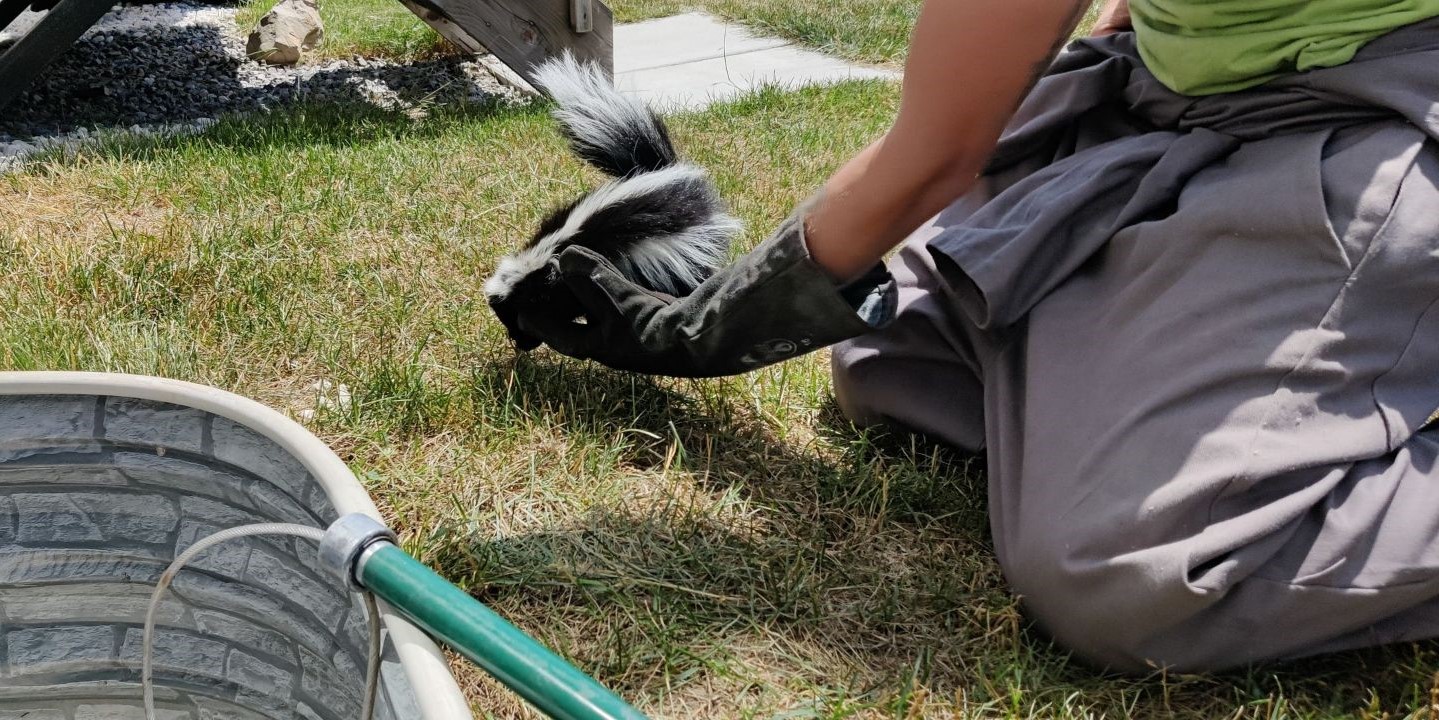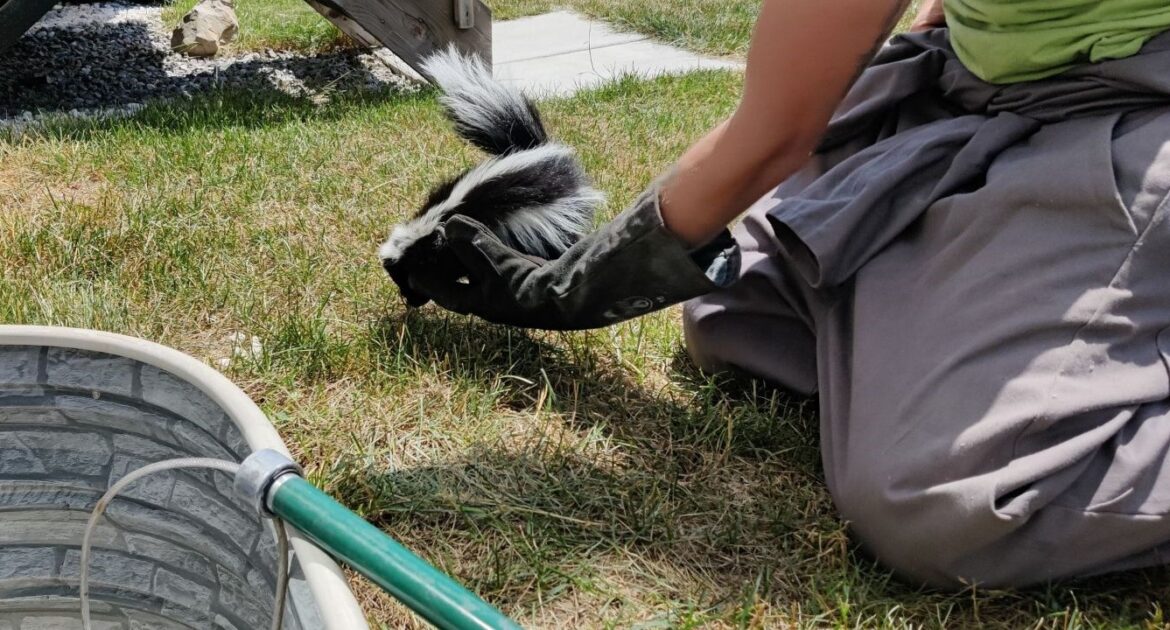If you’re a homeowner, you’ve likely encountered wildlife around your property from time to time, but few issues are as disruptive and persistent as skunks taking shelter under your deck. Understanding how to keep skunks away is crucial to maintaining your property and preventing unpleasant surprises. Skunks are known for their distinctive spray and their tendency to burrow, which can lead to significant structural issues.
Whether you’ve noticed signs of skunk activity or are unsure when a skunk’s mating season might lead to more problems, we’ll walk you through what you need to know. Drawing on our experience at Skedaddle Humane Wildlife Control, we’ve developed effective solutions for wildlife control in Hamilton and beyond to protect homes and families from the impacts of skunk activity.
The Challenges of Skunks Under Your Deck
Having skunks settle beneath your deck goes beyond occasional unpleasant odours—it can result in substantial property damage. Skunks are adept diggers and can excavate large amounts of soil when creating their dens. With time, this can undermine the stability of structures, especially decks, porches, and sheds. The more they dig, the greater the risk to your home’s foundational integrity. Beyond structural risks, skunks leave behind droppings and urine, which can attract pests, spread disease, and cause long-term contamination.
Another issue arises with the timing of skunk mating season, which occurs in late winter and early spring as warmer weather sets in. Female skunks typically give birth in May or June, and during this time, their den sites become even more active. Litters of four to seven young, referred to as kits, demand their mother’s protection and care, making it increasingly likely for encounters with homeowners or pets to result in spraying incidents. This smell isn’t just a nuisance—it can seep into building materials and linger for weeks if not addressed properly.
Adding to the complexity is the difficulty of removal. Skunks are nocturnal animals, which means they often go unnoticed until their presence is well established. Spotting fresh digging near your deck or seeing skunk tracks in the soil are tell-tale signs that they’ve moved in. However, safely removing them, especially when they’ve set up a den with babies, is not a straightforward task and demands professional intervention.
If left unattended, skunks may remain for months, especially during the winter and spring, when their activity levels peak. They rely on these dens not only to raise their young but to stay protected during colder months when they hunker down in a state of torpor—a period of extended inactivity. Proactively addressing this issue before the conditions worsen is critical to ensuring your home and property remain safe.
How to Keep Skunks Away
Preventing skunks from denning beneath your deck requires a combination of proactive measures and long-term solutions. Since skunks are opportunistic when choosing their den sites, they often gravitate toward areas that provide shelter and protection, like the underside of decks, porches, and sheds. Understanding their habits equips you to prevent access and safeguard against repeated intrusions.
One of the most effective ways we’ve found to keep skunks away is installing high-quality barriers around vulnerable structures. At Skedaddle, we recommend heavy-gauge steel mesh screens that are dug 8 to 12 inches into the ground. This depth ensures no skunk can dig through or burrow beneath it. The installation can be physically demanding, but the result is a robust solution that not only prevents current skunks from returning but also deters other wildlife looking to settle in the future.
Regular property inspections are another critical component. Look for signs of skunks before they establish dens. Early indicators can include fresh digging around structural edges, small entrance holes, or messy piles of dirt. Keeping the perimeter of your deck clear of debris and sealing any small openings prevents skunks from gaining access. However, it’s important not to attempt sealing an area if you suspect skunks are already inside. Trapping them indoors can lead to damage and even more intense odours if they spray when trying to escape.
If you suspect skunk activity but are unsure of their presence, thermal imaging technology can provide an accurate assessment. Our technicians use these tools to determine whether dens are active and locate skunks in hard-to-reach areas, ensuring the removal process is carried out safely and efficiently. When combined with humane practices, the results are reliable and long-lasting.
Beyond barriers and inspections, consider how seasonal timing impacts your prevention efforts. Avoid waiting until skunk mating season is in full swing, as the excavation process is far more complex when mothers and kits are present. Late fall, early winter, or early spring are ideal times to address skunk prevention, ensuring they do not overwinter on your property or establish dens during baby season.
Why Wildlife Control in Hamilton is Key to Skunk Prevention
Hamilton, like many urban and suburban areas, offers ample opportunities for skunks to thrive. Its mix of green areas and dense neighbourhoods creates the perfect environment for wildlife, including skunks searching for den sites. Whether you’ve lived in the area for years or have recently moved in, understanding why skunks are drawn to your property and acting accordingly can save you from future headaches.
Wildlife control is not just about removing skunks—it’s about managing the factors that attract them in the first place and ensuring they don’t return. Professional services like ours at Skedaddle take a comprehensive approach. We identify and seal all potential entry points, clean and sanitize areas contaminated by skunk activity, and ensure your property is clear of hazards like leftover food sources or accessible shelter.
One unique element of Hamilton’s wildlife challenges is the interplay of seasonal shifts and urban expansion. As skunks adapt to city life, their tolerance for human proximity grows. Decks, sheds, and porches serve as easily accessible den sites, especially when natural burrowing options are less readily available. Addressing these issues requires a holistic understanding of the area’s landscape and thorough expertise in handling wildlife.
Homeowners in Hamilton also need to consider the timing of skunk activity. During the spring and summer, when kits are learning to forage alongside their mothers, backyard gardens and lawns can become unintended attractions. Skunks are drawn to grubs and other insects in the soil, which often leads to unsightly holes in yards.
While each situation is unique, we’ve built a reputation in Hamilton for effectively addressing skunk issues with empathy and precision. It’s not simply about removing a nuisance—it’s about ensuring both homeowners and wildlife can coexist safely and sustainably over the long term. That’s why we combine humane techniques with durable home modifications that stand the test of time.
Protect Your Home Before It’s Too Late
Skunks may be small, but their impact on your property and quality of life can be significant. From structural threats beneath your deck to unpleasant encounters with their spray, acting proactively is your best defence against potential damage and disruption. Whether it’s how to keep skunks away or addressing the challenges of wildlife control in Hamilton, every homeowner can benefit from targeted prevention measures and professional support.
At Skedaddle Humane Wildlife Control, we bring decades of experience and a proven track record in safe skunk removal. Our tailored approach includes identifying problem areas, using humane removal methods, and installing long-lasting deterrents that protect your home for years to come. Don’t wait for small problems to escalate into costly repairs—take control of your property today.
If you suspect skunk activity or want to fortify your home against future intrusions, we’re ready to help. Contact Skedaddle for a consultation, and take the first step toward a safer, more comfortable home environment. It’s time to reclaim your property with confidence.




